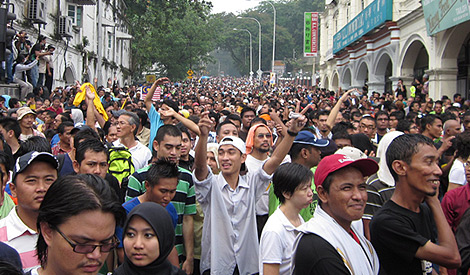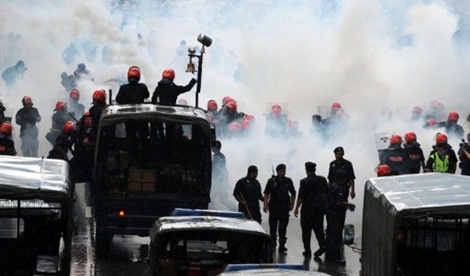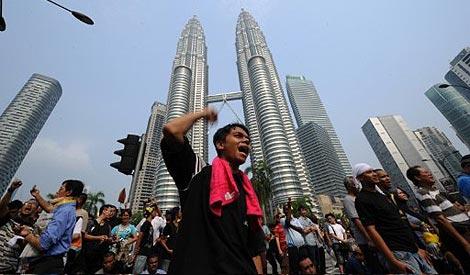COMMENT | If Bersih 2007 was remarkable for having taken place at all, its sequel almost four years later was astounding for reinventing a one-off rally as a nationwide social movement.
To rebrand an expanded Coalition for Clean and Fair Elections as Bersih 2.0 was chic in an era of compulsive ‘upgrading’. It was also strategic in linking the past to the future in the struggle for electoral reform.
What did it mean to be 2.0? It was to recall what had been achieved in actual reform – nothing. It was to set anew what was to be done – everything. This entailed activating social memory and summoning collective will but in conditions that had changed over four years.
The March 2008 tsunami was only a hint of a future for the opposition. The February 2009 coup in Perak was proof that Pakatan Rakyat’s electoral victories were vulnerable to sabotage.
The relative strengths of the antagonists were not as clear-cut as before. External losses and internal turmoil had shaken Umno. Unprecedented triumph and experimental collaboration had energised Pakatan Rakyat. Abdullah Ahmad Badawi had been ousted, while Anwar Ibrahim had returned.
 Most of all social dissent had grown. Now it splashed its causes in various colours – the anti-Lynas green, the Anak Felda orange, and the Kelantan oil royalty red. To merge them with the Bersih yellow required the inventiveness of a new organising committee that was filled with reinvented people.
Most of all social dissent had grown. Now it splashed its causes in various colours – the anti-Lynas green, the Anak Felda orange, and the Kelantan oil royalty red. To merge them with the Bersih yellow required the inventiveness of a new organising committee that was filled with reinvented people.
There was Ambiga Sreenevasan, former Bar Council president who had led the protest march to a Palace of Justice exposed by Lingam-gate. There was Sasterawan Negara A Samad Said who lent his literary eminence and octogenarian presence to dissent. There was Toh Kin Woon who had come out of academia, the Chinese education movement, the Senate, the Penang Exco, and, before it could sack him, Gerakan.
A full list would have 14 names but it would not conceal a glaring omission. There was no one from a political party.
There were two reasons for this. The 2007 rally had realised the Pakatan parties’ main aim of revitalising their cooperation. The new committee insisted on a non-partisan stance to advocate electoral reform more widely.
 Even so, Bersih 2.0 and Pakatan had a synergistic relationship. Only the Pakatan parties, and PAS especially, could mobilise on a large scale. Without them, Bersih 2.0 was a band of small NGOs with relatively few troops. But without Bersih’s civil society eminence, a Pakatan message of electoral reform might not move the politically uncommitted.
Even so, Bersih 2.0 and Pakatan had a synergistic relationship. Only the Pakatan parties, and PAS especially, could mobilise on a large scale. Without them, Bersih 2.0 was a band of small NGOs with relatively few troops. But without Bersih’s civil society eminence, a Pakatan message of electoral reform might not move the politically uncommitted.
Like its forerunner, Bersih 2.0 came out of its adverse relations with the Electoral Commission (EC). As early as in December 2010, the committee had met the EC to negotiate reforms ahead of the Sarawak state election. The EC would not accede to the eight demands of Bersih 2.0.
So the ‘Walk for Democracy to Merdeka Stadium’ on July 9, 2011 was conceived. And straight away the regime moved to stifle its birth.
Shutdown subversion
From Friday, July 8, 2011, to Saturday, July 9, at strategic points in Kuala Lumpur, police personnel and ‘riot squads’ were stationed with shields, truncheons, plastic handcuffs, tear gas, water cannons, motorcycles, cars, and trucks. In all, the police deployed 11,046 police personnel at a cost of RM2,018,850.
They were there to deter free movement within the city. To restrict access into the city, the police and the Ministry of Transport had cancelled inter-state bus permits or re-routed arriving buses away from Puduraya bus terminal.
 The results were predictable. Friday had long traffic snarls. Saturday saw deserted roads. Strategic streets were blocked by police barriers, ringed with barbed wire, or barred with police vehicles. The police swarmed over Puduraya and the urban railway stations.
The results were predictable. Friday had long traffic snarls. Saturday saw deserted roads. Strategic streets were blocked by police barriers, ringed with barbed wire, or barred with police vehicles. The police swarmed over Puduraya and the urban railway stations.
Weeks before, the regime, its allies and its instruments, which had collaborated in toppling the Pakatan government in Perak in February 2009, condemned ‘opposition-backed’ attempts to undermine the government.
Official circulars directed civil servants to stay away from an ‘illegal’ gathering. University administrators threatened disciplinary action against students who participated in an ‘unlawful’ demonstration.
The controlled media broadcast alarmist predictions of disruptions to traffic, trade, and even foreign investment. Pemuda Umno planned a counter-demonstration.
The regime declared Bersih 2.0 an ‘illegal organisation’ and the rally an ‘unlawful assembly’. Even banned was the colour of yellow, applied to articles of clothing since Bersih 2.0 had called on its supporters to wear yellow as their mark of solidarity.
The committee members were privately nervous on the eve of the rally. “Would enough marchers show up to vindicate the claims of widespread public support for electoral reform?”
In the early hours of ‘907’ the police had begun to arrest ‘suspected marchers’ in hotels near the approaches to Merdeka Stadium, at points where large crowds gathered, in roads where passers-by had their belongings searched for ‘seditious materials’, and along the rally routes.
 Even so an estimated 50,000 marchers entered the city by different means and routes. They assembled at strategic or convenient points and then moved in mass, in small groups, or individually towards Merdeka Stadium.
Even so an estimated 50,000 marchers entered the city by different means and routes. They assembled at strategic or convenient points and then moved in mass, in small groups, or individually towards Merdeka Stadium.
Police barriers and assaults made their progress torturous. Where they faced tear gas, chemical-laced sprays from water cannons, and physical beatings, they were forced to retreat. When they could, they regrouped and retraced their steps.
Most of them could not reach Merdeka Stadium. Separately, a committee delegation arrived at the gates of Istana Negara but the police stopped it from delivering a memorandum to the king.
Still Bersih 2.0 had held. It proved to be a purposeful protest that dispersed with a sense of achievement and righteous indignation. Its size, spirit, energy, and peacefulness moved its supporters at home and abroad who stayed with the rally over internet-based social media.
The significance of Bersih 2.0
If the failure to realise electoral reform after Bersih 2007 had triggered Bersih 2.0, what was achieved by ‘907’? Once again there was nothing in terms of reform simply because the rally could not budge the regime or the EC into reforming the system or themselves.
Yet Bersih 2.0 attained a deeper and unpredicted significance. So much about ‘907’ hinged on a ‘war of position’ that pitted Bersih 2.0 against the regime before the rally. There, the regime repeatedly fumbled.
If the EC had conceded some of the Bersih 2.0 demands, would that have levelled the electoral terrain straight away? No, but it might have split public support for the rally. Not even to entertain the demands effectively vindicated the allegations of electoral fraud, past and future, that had been flung at the regime and the EC.
To outlaw Bersih 2.0 was counter-productive when the king had granted an audience to Ambiga and Samad Said and advised Bersih to hold its rally in a stadium. By rejecting the committee’s choice of Merdeka Stadium after that, the regime trampled on a very Malaysian preference for compromise.
To ban the use of yellow, the ceremonial colour of royalty, was simply comical. But to accuse the EO6 (Emergency Ordinance 6) of treason was denounced as a diabolical attempt to extract false confessions that would discredit the rally and incriminate its organisers. The ploy backfired. Huge public protests and MP Jeyakumar Devaraj’s threat to go on hunger strike forced the release of the EO6 who became a national cause célèbre.
 Had the regime permitted a rally in Merdeka Stadium, Bersih 2.0 might have petered out as a moderately-sized event of no great import. But perhaps the regime’s leaders were frightened. Red Shirts had occupied Bangkok in 2010 while the uprising in Tahrir Square had overthrown Hosni Mubarak in early 2011. Perhaps the police decided that raising the stakes with a threat of force would scare Bersih 2.0 into staying off the streets.
Had the regime permitted a rally in Merdeka Stadium, Bersih 2.0 might have petered out as a moderately-sized event of no great import. But perhaps the regime’s leaders were frightened. Red Shirts had occupied Bangkok in 2010 while the uprising in Tahrir Square had overthrown Hosni Mubarak in early 2011. Perhaps the police decided that raising the stakes with a threat of force would scare Bersih 2.0 into staying off the streets.
As ‘907’ approached, electoral reform had become a secondary issue. The regime’s rejections and intimidations probably drove many exasperated citizens to swear (in the language of Shahnon Ahmad’s Reformasi allegory, SHIT!), ‘P***M**, gomen dah keterlaluan’ (P***M***, the government is too much).
Now, the Bersih 2.0 Committee would not back down and many citizens would not opt out. More Malaysians, and significantly more young Malays and more non-Malays, were goaded into joining the rally who did not participate in Bersih 2007.
Many of them found themselves at a threshold. An old dread of chaos lurked before it. Crossing it entailed an experience of a lifetime. People still spoke of electoral reform but defiance of the regime had become the unofficial but main item of the Bersih agenda.
Just as the picture of Anwar Ibrahim’s black eye caught the crux of Reformasi back in 1998, so the image of a drenched ‘Auntie Bersih’ went to the heart of Bersih 2.0. Like the latter, many citizens who would ordinarily have avoided a mass protest braved tear gas, chemical sprays and police assaults in a rite of passage into civil society activism.
When the rally was over, many exhausted but spirited first-timers would say that they had lost or conquered their fears of protesting, of the police, and of arrest.
‘Goaded into defiance’, did we say? There is no reason after all to credit the regime’s crude provocations and brutal conduct for that.
Mahatma Gandhi, someone observed, understood that “the challenge was not to bring enlightenment about injustice in the world. People already know the injustices.” Rather, “the problem is getting them to act on what they already know is wrong”.
For Gandhi, therefore, “the purpose of politics, in particular non-violent civil disobedience was … to act as a stimulant to goad people, goad the indignant but still passive bystanders, to goad them into action.”
What could have more genuinely captured Bersih 2.0 as a Gandhian moment than the moral examples of its two iconic leaders, a Brahmin woman lawyer and a silver-haired national laureate, as well as a tenacious MP who vowed to go on a hunger strike rather than yield to unjust persecution?
Part 1: The Bersih rally that helped bring 2008 tsunami
Part 2: Bersih 3 – the attempt to reclaim Kuala Lumpur
KHOO BOO TEIK is the author of ‘Beyond Mahathir: Malaysian Politics and its Discontents’ and, as reminded by P Ramakrishnan, a member of Aliran.

